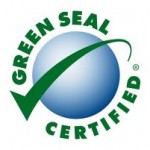It’s no mystery; environmentally friendly products are the largest growing trend within the labeling and packaging industry. We’ve focused the last couple of months on this trend in a few of our blog posts. Today, we’re going to highlight the latest news involving the infamous “Green Seal Label.” To receive the Green Seal Certification Mark (pictured below), a product must go through a rigorous process to prove it has very little effect on human health and the environment. We here at Whitlam Group are dedicated to informing our customers and friends about new developments within our industry. Today is no different, especially for all of you working within the cosmetics industry.
 Earlier this week, the non-profit organization, Green Seal, announced new principles for sunscreen, nail polish, deodorant and other personal care products. Certain organizations will have to make some adjustments to receive Green Seal’s stamp of approval.
Earlier this week, the non-profit organization, Green Seal, announced new principles for sunscreen, nail polish, deodorant and other personal care products. Certain organizations will have to make some adjustments to receive Green Seal’s stamp of approval.
The GS-50 standard is specifically designed for products which stay on the body. This goes along with GS-44, which sets the standards for products that are washed off the body. Cheryl Baldwin, vice president of Green Seal, stated the reason why the GS-50 standard was implemented to compliment the GS-44 is because “the general functionality of the products are different and ultimately their fate in the environment is different.”
Some of the banned ingredients included within the GS-50 standard are tricloson, bisphenol A (BPA) and phthalates. Also, products cannot be tested on animals and they cannot contain carcinogens.
If you plan to apply for the Green Seal Certification Mark, you must be prepared to provide documentation on your air emissions, energy and water use, and waste water related to your manufacturing process.
We here at Whitlam Group hope this information will help you to better understand the latest Green Seal standards. Let us know if you have any more questions about Green Seal Certification or the new GS-50 standards.
Let us Help With Your Next Label ProjectGet Started Today!
Fill Out Your Info To Receive A Speedy Quote!